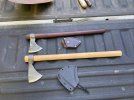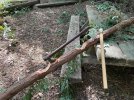For scrounging firewood in a wide range of environments I use a Council Tools Boy's axe and a cheap handsaw from the local Ace hardware store. Old downed wood is full of dirt, rocks, moss, bugs, hardened resin, charcoal, and poop (from something). The little Boy's axe packs enough punch to break down larger pieces into manageable 4' to 8' lengths that I can walk back to camp with on my shoulder. Once there I can set up some sort of stable platform to saw things to the dimension I want. Often I don't bother and just feed the larger wood in the fire a little at a time. Bucking dry, hard wood (even pine) into little two foot pieces wastes a lot of chips, exposes your axe blade to dirt underfoot at speed over and over again, and requires a silly balancing/stabilizing act as the logs gets shorter and shorter. I did it for years and have come up with my own safety precautions and techniques that have mitigated the effects of errant swings when tired and glancing blows off hidden knots, etc. The unpleasant truth is that axes are not designed to chop/buck seasoned wood. They're made (almost exclusively) for green wood. A standard one-handed carpenters saw is just so much simpler in every way. Not as romantic, I'll grant you that. Just simpler.
I also keep a cheap, weather resistant full-sized axe strapped to my vehicle somewhere inconspicuous. If I luck into some big rounds someone's left in the woods I can split them up in a couple of swings or I can use it to cut through larger downed trees that are blocking a road I want to take or in the way of a potential camp site. A Fiskars would probably work. An Estwing is too slender for larger splitting chores in my opinion so it's not a double duty tool. I use a no-name Chinese made junker with a fiberglass handle. Most of the time it just sits there almost invisible to the passers by.
I have dozens of vintage axes but these are what I take. I don't have to worry about them going missing or getting a chip in the blade. In a true survival situation or if the world ended tomorrow I would bring out my best. If you're of smaller stature then pick your tools to fit your size and build fires that are in proportion to your physical stature. If you can bandy about a 3.5lb head on a 36" haft then great! For some, though, the "boy's axe" is full-sized. No need to macho up and swing a 5 pounder. You occasionally see small men and women in timbersports swinging full-blown racing axes and their technique and accuracy falls apart after a few chops. They'd be better off with something more suited to their size, strength, and stamina. Do what's right for you in this regard.
If I'm in a canoe for the day or just bumming around the woods I'll bring either a HB pattern or one of
these.
And a decent knife.



